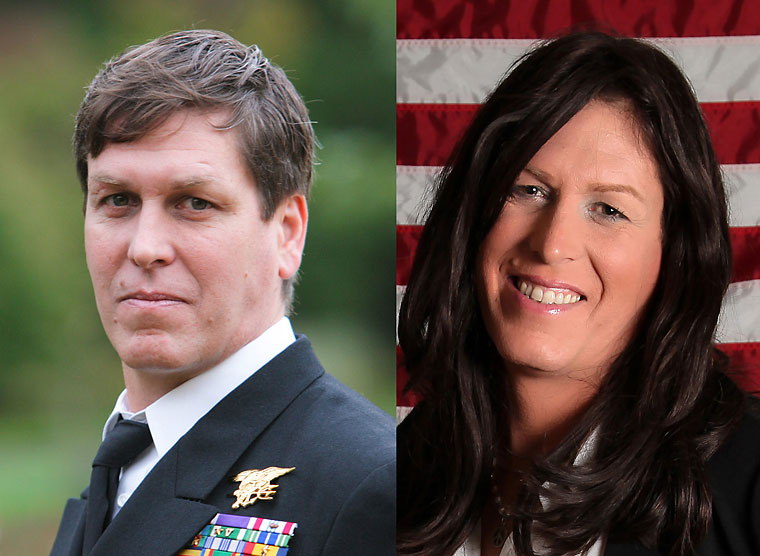 Public Policy
Public Policy Taking the Air out of the Ban on Transgender Troops

The book Warrior Princess told the tale of Navy SEAL Chris Beck, who after seven combat tours went through gender reassignment (and public scrutiny) after retiring from the service.
UPDATE: This article originally appeared on August 19, 2014. On July 26, 2017, U.S. President Donald Trump tweeted that transgender personnel could no longer serve in the U.S. military; the ramifications of that message have yet to be determined.
***
In 2011 when the U.S. military stopped banning gays from serving, it didn’t lift restrictions on the transgender community, a population that gets lumped in with gays and bisexuals under the LGBT umbrella. That exclusion wasn’t an oversight. It was a calculated decision based on a traditional but, according to a new paper in the journal Armed Forces and Society, flawed understanding of physical and psychological robustness.
“Unlike the rationales that justified excluding gays, lesbians and bisexuals, and that emphasized operational issues including readiness, cohesion, recruitment and morale,” former U.S. surgeon general Jocelyn Elders and four co-authors write in the journal, “the rules barring transgender military service are, for the most part, embedded in medical regulations, and are premised on assumptions about the medical fitness of transgender personnel.”
That perceived fitness deficit rests on four assumptions Elders and company debunk in turn: transgender troops are too prone to mental illness; the military can’t adequately monitor cross-sex hormone therapy — and if that’s the case, don’t even think about gender reassignment surgery; and lastly, transgender personnel just aren’t medically capable of deploying routinely.
None of those barriers are borne out by research, the authors write, and where the issues raised do require some accommodation they find it’s no different from the leeway already given everybody else in uniform. “Simply treating transgender service members in accordance with established medical practices and standards, as it does with the provision of all medical care, is all that’s needed to end the unnecessary and harmful policy of discrimination against transgender service,” they conclude.
Some 18 countries currently allow transgender people to serve openly, and while the U.S. ban remains in place, analysis by people like Elders and her co-authors may help change the policy. As U.S. Secretary of Defense Chuck Hagel told ABC News in May, “I’m open to those assessments, because — again, I go back to the bottom line — every qualified American who wants to serve our country should have an opportunity if they fit the qualifications and can do it.”
How many Americans are barred?
The authors cite a UCLA study that there are 15,500 transgender individuals in uniform right now, 8,800 on active duty and the rest in the National Guard and Reserves, and that 134,000 vets fit into the category (“individuals who do not identify with the physical gender that they were assigned at birth”). Although that’s less than 1 percent of the total U.S. armed forces, it’s double the density of transgender people found in the U.S. population as a whole, where an estimated 700,000 transgender adults comprise 0.3 of the adult population.
Such outsize representation isn’t a fluke. As Julia Baird wrote in a piece titled “The Courage of Transgender Soldiers” last February in The New York Times:
A Harvard study published last year found that most transgender military personnel in America are white, educated and middle-aged. And most eventually transitioned from male to female. It also found that 20 percent of transgender people had served in the military — double the rate of the general population. (There is a theory that many seek “hypermasculine” experiences to suppress their desire to be female.) A University of California survey found almost all — 97 percent — were not able to transition until after they left the service.
But there’s a shift happening. According to data from the Department of Veterans Affairs, the number of veterans seeking advice on transgender issues has doubled in the past 10 years. And hundreds of currently serving transgender members of the armed forces have joined an underground support movement called SPART*A.
Despite those relatively modest numbers, transsexual troops have been in the news a lot of late. Part of that likely follows from the saga of perhaps the most prominent transgender G.I. –the imprisoned Chelsea Manning, who as Private Bradley Manning released classified documents to WikiLeaks. (The book Warrior Princess likely lands former Navy SEAL Kristin Beck comes a close second.)
Medical Malarkey
In March, a half-year after Manning announced, “I am Chelsea Manning. I am a female,” the Palm Center, which has looked at issues of sexual minorities in the military for the last decade, released a report that reviewed the issue and called for an end to the prohibition.
The five-member commission that prepared the report included co-chairs Elders and Alan M. Steinman, a retired Coast Guard rear admiral and medical doctor who had served as director of Health and Safety for the service. The other three members were George R. Brown, a psychiatry professor at East Tennessee State University; Eli Coleman, director of the Program in Human Sexuality at the University of Minnesota; Thomas A. Kolditz, a retired brigadier general who led the Department of Behavioral Sciences and Leadership at West Point for 12 years. This same squad later penned the article that appears in Armed Forces and Society.
Both the Palm Center report and the journal article home in on the medical, as opposed to the social or legal, grounds for ending (or retaining) the ban, although the Palm report spent more space examining some of the cultural and military readiness issues than did the more tightly focused journal article.
The medical defense has popped up in U.S. courtrooms a few times since 1981, and in those cases the courts have accepted the military’s argument that retaining transgender personnel puts an unreasonable safety burden to either the service or the individual.
The secretary of defense’s statements notwithstanding, the Pentagon is so far sticking to its guns. “In doing these reviews, the department considers that service members must serve in austere environments, many of which make necessary and ongoing treatments related to sex reassignment and many other conditions untenable,” a Defense spokeswoman emailed the Washington Post in April.
When facing the boot for medical reasons you can request a waiver on an individual basis—shortly after 9/11 a third of enlistees requesting such waivers got them– but no waivers are granted for conditions that would have prevented a person from joining or remaining in the military in the first place (like being transsexual!).
The authors also examined the barriers presented by the transgender personnel once they started medically supervised efforts to bring their bodies into line with the gender they identify with. Both hormonal regimens and surgery are not materially different from options offered other service members who aren’t being involuntarily discharged. In one case, Elders and her team note, “the military’s unwillingness to allow any transgender service members to undergo cross-sex hormone therapy is inconsistent with the fact that many non-transgender personnel are permitted to take hormones.”
Cross-gender surgery is a more intrusive and potentially debilitating process, the authors concede, but “it is important to recognize that regulations permit service members to have elective cosmetic surgeries at military medical facilities, and that some of those elective procedures risk post-operative complications that can be more serious than those of medically necessary gender-confirming surgeries.”
That both of these options may intrude on the ability to deploy to a dangerous and remote corner of the world is also not a reason to automatically discharge or reject transgender troops:
Transgender service members, however, are automatically discharged, in part because of assumed constraints on their deployability and medical readiness, even though such constraints would apply to no more than a few hundred transgender service members at any one time, and would normally last less than 12 months allowed for deferrals of reassignment. In contrast, non-transgender service members are given multiple opportunities to demonstrate their deployability and fitness for duty despite medical limitations, and many are retained even if they are not fully deployable or fit. Even those service members deemed permanently unfit “may be retained as an exception to the general policy rule” if their skills or experience warrant continuing service.
But in a sense it’s the psychological concerns that create the highest bar.
Even transgender service members who do not wish to take hormones, have surgery, or undergo any other aspect of gender transition are subject to discharge under the psychological components of the accession and retention regulations.
While there are studies that suggest transgender service members do have a higher incidence of self-harming behavior, that’s not the rationale for the ban. Instead, it’s the notion that being transgender by and of itself is the mental problem, not any cascades from gender issues. While that’s out of step with current psychological understanding –the latest Diagnostic and Statistical Manual no longer lists ‘gender identity disorder’– it is in line with historical reaction – the Diagnostic and Statistical Manual used to list ‘gender identity disorder’ up until the current edition. As the American Psychiatric Association made clear in releasing the new DSM, “gender nonconformity is not in itself a mental disorder.”
***
To see the Armed Forces & Society paper for free, click here.



















































































